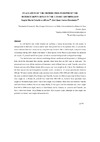Identificador persistente para citar o vincular este elemento:
https://accedacris.ulpgc.es/jspui/handle/10553/760
| Campo DC | Valor | idioma |
|---|---|---|
| dc.contributor.author | Caballero Alfonso, Ángela María | en_US |
| dc.contributor.author | Castro, J.J. | en_US |
| dc.date.accessioned | 2009-10-08T02:31:00Z | - |
| dc.date.accessioned | 2018-06-18T06:51:49Z | - |
| dc.date.available | 2018-06-18T06:51:49Z | - |
| dc.date.issued | 2007 | en_US |
| dc.identifier.other | 2034 | - |
| dc.identifier.uri | https://accedacris.ulpgc.es/handle/10553/760 | - |
| dc.description.abstract | Is well known that world fisheries are suffering a strong deterioration; for this reason, is indispensable to find other resources and to study their possibilities to be exploited. Here we present the results obtained from two fishery survey, using fish traps, between 200 to 1200 m depth, along the Canary Archipelago during 2003. Depth distribution of three species of the Heterocarpus Genus was analyzed (H. ensifer, H. grimaldi and H. laevigatus) in order to increase biological and ecological knowledge. The studied areas were selected considering climatic conditions and the proximity to fishing port from which the handmade fleet operate, specially those boats that use fish traps as main gear. The prospected areas were off the southwest of Lanzarote, south of Gran Canaria, south Tenerife, west of La Gomera and east of La Palma islands; Heterocarpus ssp. were caught in all of them. The distribution of the three species was not homogeneous in depth, neither latitudinally. H. ensifer predominates between 300 and 700 meters depth, although some specimen were found at 800, 1000 and 1200 meters, mostly in the more occidental islands of La Gomera and Tenerife, because less Heterocarpus than in Gran Canaria were caught in La Palma; H. grimaldi was found from 900-1100 m., however three specimens were caught at 400 meters depth, most of them were caught in La Gomera, others were also found in Tenerife and Gran Canaria seafloor, but not too many; finally, H. laevigatus (the less abundant one), were caught from 900 to 1000 meters depth, mostly in Gran Canaria and La Gomera, en Lanzarote and Tenerife, just two of them were found. In La Palma we just have Heterocarpus ensifer, although we also caught one grimaldi, we doesn’t have weight information of it. | en_US |
| dc.language | eng | en_US |
| dc.source | Simposio Internacional de Ciencias del Mar. Simposio GLOBEC-IMBER España, Valencia, del 28 al 31 de marzo de 2007, L'Oceanogràphic [Archivo de ordenador] : libro de resúmenes = Books of abstracts, pp. 61 | en_US |
| dc.subject.other | Pesca | en_US |
| dc.subject.other | Canarias | en_US |
| dc.title | Evaluation on the distribution in depth of the heterocarpus genus in the Canary Archipielago | en_US |
| dc.type | info:eu-repo/semantics/conferenceObject | en_US |
| dc.type | ConferenceObject | es |
| dc.identifier.absysnet | 515063 | - |
| dc.rights.accessrights | info:eu-repo/semantics/openAccess | es |
| dc.type2 | Actas de congresos | en_US |
| dc.identifier.ulpgc | Sí | es |
| item.fulltext | Con texto completo | - |
| item.grantfulltext | open | - |
| crisitem.author.dept | GIR ECOAQUA: Biodiversidad y Conservación | - |
| crisitem.author.dept | IU de Investigación en Acuicultura Sostenible y Ec | - |
| crisitem.author.dept | Departamento de Biología | - |
| crisitem.author.orcid | 0000-0001-9577-5957 | - |
| crisitem.author.parentorg | IU de Investigación en Acuicultura Sostenible y Ec | - |
| crisitem.author.fullName | Castro Hernández, José Juan | - |
| Colección: | Actas de congresos | |
Visitas
107
actualizado el 31-oct-2024
Descargas
45
actualizado el 31-oct-2024
Google ScholarTM
Verifica
Comparte
Exporta metadatos
Los elementos en ULPGC accedaCRIS están protegidos por derechos de autor con todos los derechos reservados, a menos que se indique lo contrario.
